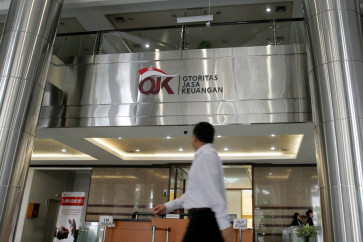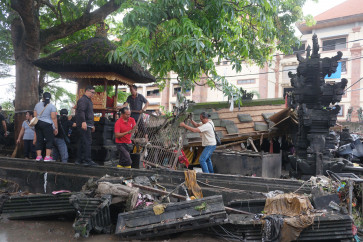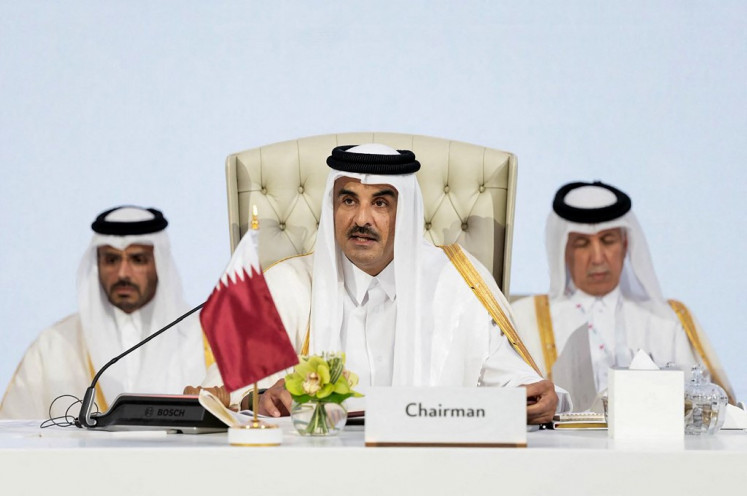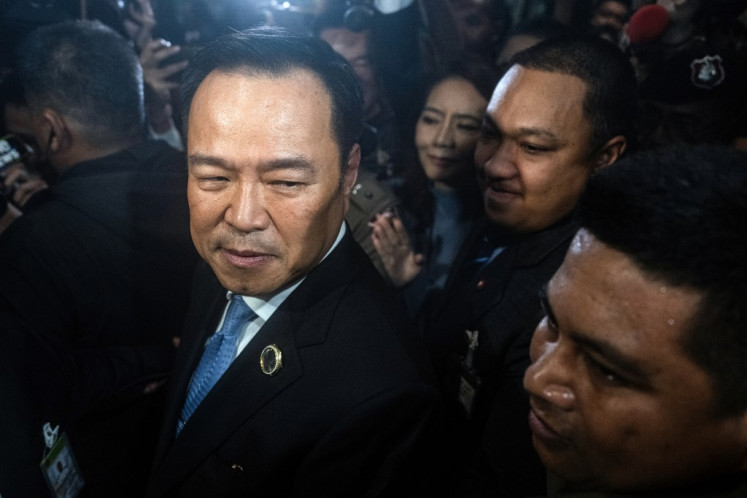Popular Reads
Top Results
Can't find what you're looking for?
View all search resultsPopular Reads
Top Results
Can't find what you're looking for?
View all search resultsKerkhoff Poucut Cemetery, testifying to the Aceh War
A semicircular gate welcomes everybody visiting Kerkhoff Poucut Cemetery, with a short corridor leading one’s view to old gravestones bearing Dutch names
Change text size
Gift Premium Articles
to Anyone
A
semicircular gate welcomes everybody visiting Kerkhoff Poucut Cemetery, with a short corridor leading one’s view to old gravestones bearing Dutch names. The white marble walls of the gate are also adorned with the names of Dutch soldiers buried in the graveyard.
Kerkhoff Poucut is a Dutch military burial ground located in the hub of Banda Aceh, the capital of Aceh. The cemetery name is a combination of the Dutch word kerkhof, meaning a churchyard or graveyard, and the Acehnese word poucut or poteu cut, meaning a prince.
Taking care: Muhammad Riza, the son of the cemetery’s caretaker, helps his father’s maintenance work by repainting gravestones and cleaning grass fields.Today Kerkhoff Poucut is recorded as the largest Dutch military cemetery outside the Netherlands. There are around 2,200 graves of white Dutch soldiers as well as recruits from the ethnic groups of Ambon, Manado and Java, besides four Dutch generals, including Gen. Kohler.
“This graveyard has existed here for a long time. But it’s been maintained and guarded since the descendants of former Dutch soldiers visited Aceh around 1976,” said Rusdi Sufi, director of the Aceh Documentation and Information Center (PDIA).
Based on the dates on the gravestones, the oldest grave dates back to Dec. 27, 1873, when a Dutch naval officer died from cholera and was buried there. In the middle of the cemetery is the tomb of Meurah Pupok, the only beloved son of Sultan Iskandar Muda.
Meurah Pupok was punished by stoning as ordered by Sultan Iskandar Muda for having committed adultery with the wife of a young officer assigned to train Aceh soldiers. Meurah Pupok was stoned in public as evidence that the Sultan would impose the same penalty on anybody with the same sin. The choice of the Dutch graveyard served as a severe punishment because his son was thus seen as equal to infidel Dutch soldiers.
At present, the cemetery is under the supervision of the PDIA and the Banda Aceh city administration with aid funds from Stichting Peutjut-Fonds, a foundation owned by the families of former Dutch soldiers established on Jan. 29, 1976 after the visit of Dutch military police Col. (ret.) J.H.J. Brendgen.
“Every year they raise maintenance funds from family members,” said Rusdi Sufi. But in the last few years, the funds collected have been decreasing because many younger-generation family members are less enthusiastic about their country’s former war affair. In fact, most of the cemetery’s maintenance is funded by the foundation.
Hot spot: Two visitors take each other’s picture on a grave using cellphones. The well-maintained Kerkhoff cemetery looks more like a park than a graveyard.“As a representative of Stichting Peutjut-Fonds in Aceh, I’m afraid the graveyard may in the future be neglected unless the local government promptly takes over the responsibility,” added Rusdi Sufi.
Around 1978, under governor Muzakir Walad, there was pressure to level the burial place and replace it with a more beneficial building like a market or mall. Some people disagreed with the presence of the cemetery of ex-colonizers, mostly being non-Muslims. Furthermore, it is strategically situated and near Baiturrahman Mosque — the pride of the Aceh public.
“But fortunately, the governor wouldn’t allow it to happen because the burial place testifies to Aceh’s history, so it should be maintained and preserved to enable future generations to get acquainted with their past through the existing heritage,” indicated Rusdi Sufi.
So far the cemetery has remained well maintained so that it looks more like a park than a scary graveyard. Almost every day many local people visit this place only for a walk like tourists and even for posing before photographers. Amri, 50, who guards and maintains the graveyard, said the guide book of the city’s tourism office had included Kerkhoff Poucut as a recommended historic tourist destination.
“I’ve often seen foreign tourists visiting the cemetery though not every day,” noted Amri, who as a caretaker has to make sure that the burial ground always looks clean and attractive. He also repaints gravestones with fading colors due to changing weather. Working there since 1989, Amri was entrusted with the duty by the foundation.
Memorial: Kerkhoff Poucut Cemetery, located near the Aceh Tsunami Museum. The cemetery has become a historic tourist destination.“This job demands no special skill, but I’ve got to work seriously and sincerely to keep up my enthusiasm,” he said. As a native of Aceh, Amri has no objection to maintain and guard the 2-hectare complex with a monthly salary of Rp 1 million. “There are those who want to damage the gravestones just for fun. It was even more the case before fences were built several years ago,” added Amri.
According to Amri, it’s the historical values of all the cemetery’s contents that arouse his passion for the care of this heritage, instead of the salary he receives from the foundation.
“This serves as historical evidence to be seen by Aceh’s succeeding generations so that they will be familiar with and learn from the history of Aceh people’s struggle against colonialism, which claimed lots of lives and caused material losses,” concluded Amri.
— Photos by Hotli Simanjuntak












